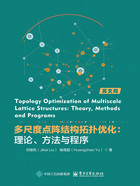
1.2 The fundamentals of density-based and homogenization-based topology optimization
1.2.1 Density-based method
The goal of topology optimization is to find the material distribution within a prescribed design domain subject to the design objective and constraints. A classic formulation is the binary compliance minimization problem, to find a material distribution consisting of solids and voids that minimizes the structural compliance (maximize the deformation resistance) subject to a volume fraction constraint (use a limited amount of materials to realize lightweight design effect). However, the binary compliance minimization problem is known to be ill-posed[7]. One solution is to relax the binary condition by including intermediate material densities in the problem formulation. In general, the minimum compliance problem is defined as,

where F is the vector of nodal forces and U (x) is the vector of nodal displacements. By incorporating a volume constraint, the minimum compliance optimization problem is further formulated into:

where x is the physical densities, n is the number of elements used to discretize the design domain, α is the vector for element volumes, and  is the prescribed solid material volume upper limit. The nodal force vector F is independent of the design variables and the nodal displacement vector U (x) is the solution of KU=F.
is the prescribed solid material volume upper limit. The nodal force vector F is independent of the design variables and the nodal displacement vector U (x) is the solution of KU=F.